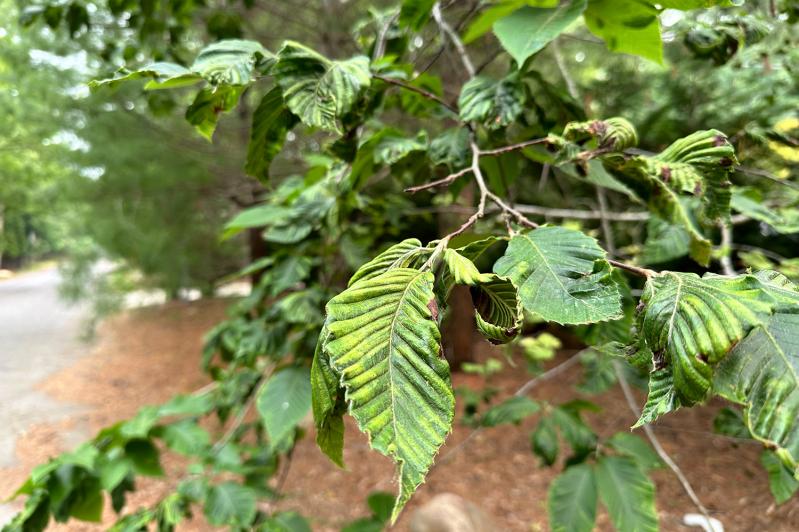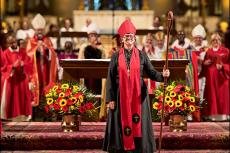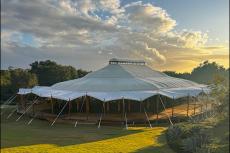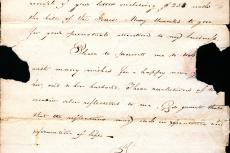Earlier this month, while watering a large American beech tree in North Haven that had been ravaged by beech leaf disease, a tree care technician was searching around the roots for four-leaf clovers. “When I find them, I put them in my phone case,” he said, showing off his lucky finds in the back of his case.
Unfortunately, it will take much more than luck to save the beech trees on the East End. Many are showing advanced stages of infection from the disease, referred to as B.L.D., which was discovered in Ohio about a decade ago. A microscopic wormlike creature called a nematode feeds on the buds of the trees, causing them to lose their leaves. The tree, deprived of its food source, can eventually die.
The New York State Department of Environmental Conservation says on its website that “currently there is no known way to control or manage this disease,” which “can kill beech trees of all ages in two to seven years.” The disease affects the beech trees common in forests here as well as ornamental beech trees.
“It’s hard to believe that it was only June 2021 when we first saw a scattering of symptomatic foliage in a client’s garden, and two years later, most beech trees have been impacted at some level,” said Matt Hartline, a board-certified master arborist at Bill Miller and Associates in Water Mill.
Can anything be done?
Last fall, the D.E.C. gave special-permit use for Broadform, which had previously been banned due to concern over its interaction with groundwater. Long Island gets its drinking water from a single aquifer. Should it become tainted by pesticides or septic runoff, or, alternately, depleted from overirrigation, there wouldn’t be enough Poland Spring to go around. The fact that the D.E.C. approved Broadform indicates the environmental cost if the beech trees are lost.
“The direct application [of Broadform] includes the recommendation to use a spreader sticker to improve the effectiveness of the product and decreases the potential for the product to reach the ground and impact groundwater resources,” said the D.E.C. in a statement. “The product is classified as ‘restricted use’ in New York State, which means its use is limited to certified applicators or people working under their supervision. Broadform on Long Island is utilized only by researchers and tree care experts investigating best management practices to mitigate damage to beech.”
“It’s somewhat of an experiment,” said Jackson Dodds, an arborist and tree surgeon. “We made applications in the fall. Some trees flushed out much better and earlier than the year before. However, other trees didn’t have the same response. It’s hard to measure. It’s not like a light switch, where you spray and it will be perfect.”
“It’s going to be spring of 2024 before we’re able to gauge the efficacy of Broadform in our gardens,” agreed Mr. Hartline.
In addition to Broadform, every arborist who spoke to The Star recommended deep-root feeding and keeping beeches as healthy as possible.
“It’s important to have an undisturbed understory below beech trees, without excessive watering,” said Mr. Dodds. “People are irrigating their lawns, trying to save a little grass, and potentially killing a historic tree in the meantime.”
As the beech tree canopy thins, more sun hits the understory, creating a perfect environment for invasive species to thrive. Mr. Dodds recommends removing any nearby invasive species, especially Japanese knotweed, ailanthus trees, and mile-a-minute, lest they spread.
Mr. Hartline scanned a stand of beech trees on public land. “Can these trees recover?” he asked rhetorically. “It feels unlikely, these unmaintained trees. But in a garden, how do you know it’s too late?” He was clearly grappling for an answer, like everyone else who loves trees. “When it’s too upsetting to be in your garden with the sick tree, that may be when it’s time. Or if the tree presents an unacceptable risk.”
Mike Gaines, owner of C.W. Arborists in East Hampton, cautioned against acting hastily. “People need to have patience, and we don’t need to act immediately. We need to know what we’re dealing with,” he said. While he indicated that he too had seem some positive responses in trees treated with fertilizers and fungicides (Broadform is a fungicide, though he wouldn’t confirm he had used it), no silver bullet had presented itself. “There’s cause for concern, but no cause for hysteria,” Mr. Gaines said. He fears that too many people will assume sick trees are dead and remove them prematurely.
Mr. Hartline said most infected beech trees will deteriorate gradually.
“There will be die-back in portions of the canopy, and branch failure where agents of decay compromise the tree’s structural integrity,” he said. Removing a tree has to be done on a case-by case basis, depending on its proximity to “targets.” “If there is a target, the only way to eliminate the threat may be to remove the tree,” Mr. Hartline said before quoting Bill Miller, the founder of his company: “There is inherent risk with the beauty of living with trees.”
“If a declining beech tree is in a place where it can deteriorate and do no harm, there is very good justification to let it be,” Mr. Hartline said. “Cavity-dwelling creatures, like birds and raccoons, they will use it as habitat.”
In fact, many birds that nest in beech trees, such as the tufted titmouse and the white-breasted nuthatch, are hatching in the next few weeks. Many won’t fledge until early August. Consider trimming trees only after, to avoid killing helpless baby birds, hidden in cavities.
The questions surrounding B.L.D. plague local governments as well. Chris Fiore, the mayor of North Haven, which was once predominantly beech forest, sent a letter to residents on June 3 saying that the village is exploring management options for its beech trees. Andy Gaites of East Hampton Town’s Land Acquisition and Management Department wrote in an email, “There is not much we can do other than noting where it is occurring and keeping up to date with the D.E.C. if management recommendations become available.”
No municipality yet has a re-planting plan. But homeowners worried about barren landscapes can act right now to plant native trees, like oaks, hickories, willows, and sassafras.
“I’d cite the ancient proverb that the best time to plant a tree is 20 years ago, and the second-best time is now,” said Mr. Hartline. “Are we giving up on the beech trees, or are we planting an insurance policy? How do you incorporate a new generation of trees with a struggling overstory? That is the art of design.”




